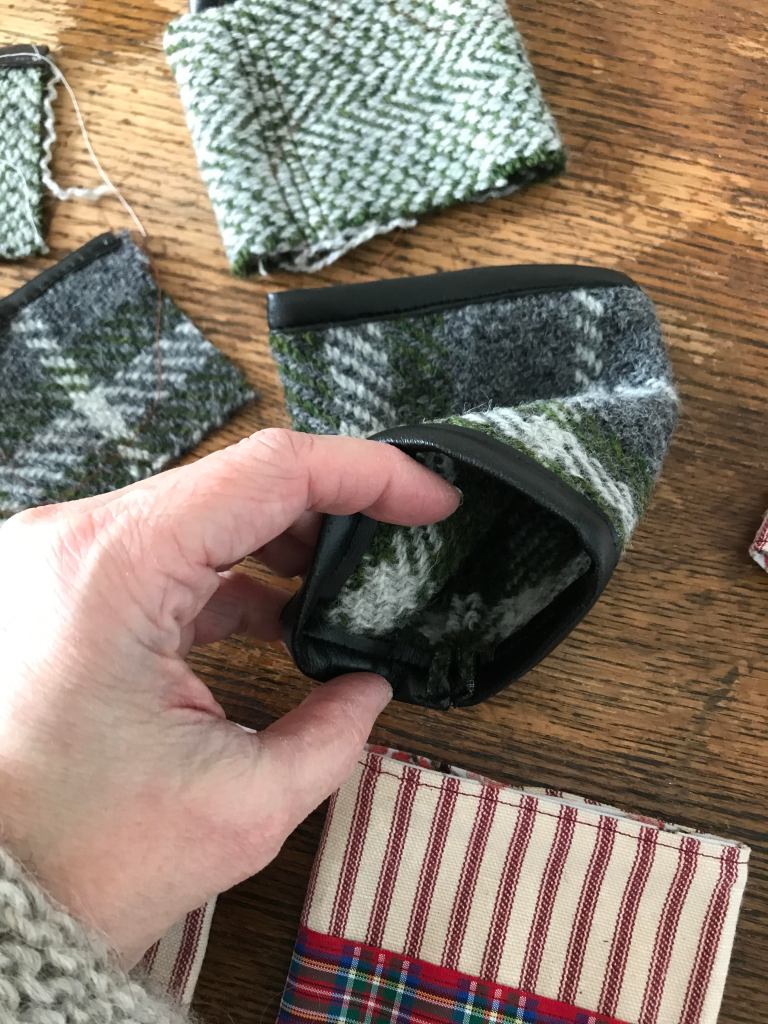
Hello, friends. I love to sew. I learned to sew on my mother’s Singer sewing machine in the 1970s. Yes! What a long time ago! I was so proud of that yellow knit short sleeved t-shirt. It had coordinating navy ribbed cuffs and neckband to match the navy blue flowers printed on the cloth. I’m not sure if I was a model student (I probably was not), but my mother was a good and patient teacher. I still like to make clothes for myself and family members, but sewing clothing with my handwoven fabrics isn’t something I embrace. At least, not yet, anyway. Who knows. Never say never…
Sometimes one does not have an excess of handwoven fabric hanging around to make, say, a big cushion cover or handbag, but this Christmas I did use some of my handwoven wool to make flask covers for my sons and husband. (Here is the post where I showed pictures of these). I liked the concept a lot and have been mulling it over since December. There were things about my first few flask covers that I wanted to improve (i.e. avoid fake leather). So below, you can see some pictures I took of the samples and techniques that sometimes worked (and mostly didn’t!) as I tried to make an improved flask cover:

Take two:

Take 3:

Takes 4 and 5:

And we’re almost there…

There are still a few things I’d like to “tweak” for this concept, but mostly it has to do with basting, interfacing weight selection, and stitch lengths. My husband likes the feel of the real leather band vs. the vinyl that I used on my first attempts. So, overall, progress was made but not without a bunch of false starts and miscalculations.
Just off of the floor loom are new kitchen towels! I really liked the teal and jade warp. The cloth takes on a different look depending on the weft color. I used a French blue cotton and a navy blue cotton. Here is a picture of both:

On the floor loom today are more log cabin placemats in soldier blue; these should be “shop ready” by next week. The warping reel is poised to receive threads for moss green log cabin placemats.
And last, but not least, here is what is on the rigid heddle loom right now:

This cloth features a black wool warp sett at 7.5 epi (I used worsted weight knitting yarn) and a weft of some leftover wool sock yarn, which I think is a Lana Grossa product. I like the effect of the variegated wool. And yes, “it is just plain weave,” as many of my Instagram followers call it. “Just plain weave?!” Poor plain weave, it is undervalued. Plain weave holds so much potential! And, like a lot of things, plain weave does not mean “easy weaving.” Sometimes the things that we perceive to be basic and simple are not so: think of stitching a straight line on a sewing machine, drawing a circle by hand, or playing a C major scale on the piano. It takes practice and when done well, can be quite lovely.
On that note, I am off to the loom.
Be safe and well, friends.
Kate K.

What a nice post, luv. I especially love your ode to plain weave. It made me smile. 🥰
LikeLike
Why, thank you! I love plain weave! 🙂
LikeLike
All of your content is just amazing 🙂
LikeLike